An Indirect Test of Validity: Two
Examples
1. An Example of a Valid Argument. Consider this argument again (#5 on the problem sheet):
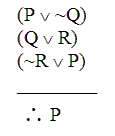
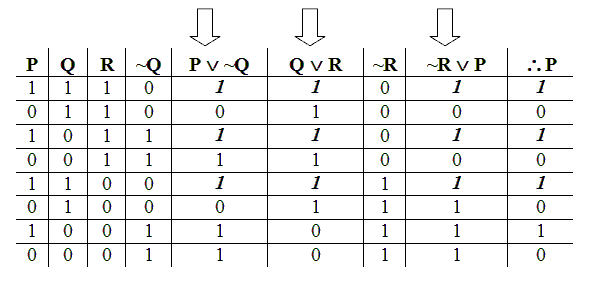
In every valuation where the premises are all true (the first, third, and fifth valuations), the conclusion is also true.
Now let's use the Indirect strategy on this same argument, and show indirectly that it's valid. To do this indirectly, we do what we always do in an Indirect Argument: assume the opposite, and then show how that assumption leads to an impossible consequence; since that consequence is impossible (and so false), the assumption of the opposite which led to that result must also be false.
Since we're trying to show that this argument is valid, we assume the opposite by assuming (for the sake of argument) that it's invalid.
Now what, precisely, does it mean to assume that the argument is invalid? Well, if the argument is invalid, then there must be a Validity Counterexample for that argument. So to assume the argument is invalid amounts to assume that there's a Counterexample for the argument.
And what is a Validity Counterexample anyway? By now, you must know that much: it’s a possible situation where all the premises of the argument are True, but the conclusion is False.
So, to sum this up: to show indirectly that the argument is valid, we assume the opposite -- that is, we assume that the argument is invalid -- that is, we assume that there's a Counterexample – that is, we assume that there's a possible situation where all the premises are True, but the conclusion is False.
So this is what it looks like to assume the opposite (to assume that the argument is invalid):
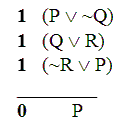

We already built a truth table for this argument, and found that it is valid.

In every valuation where the premises are all true (the first, third, and fifth valuations), the conclusion is also true.
Now let's use the Indirect strategy on this same argument, and show indirectly that it's valid. To do this indirectly, we do what we always do in an Indirect Argument: assume the opposite, and then show how that assumption leads to an impossible consequence; since that consequence is impossible (and so false), the assumption of the opposite which led to that result must also be false.
Since we're trying to show that this argument is valid, we assume the opposite by assuming (for the sake of argument) that it's invalid.
Now what, precisely, does it mean to assume that the argument is invalid? Well, if the argument is invalid, then there must be a Validity Counterexample for that argument. So to assume the argument is invalid amounts to assume that there's a Counterexample for the argument.
And what is a Validity Counterexample anyway? By now, you must know that much: it’s a possible situation where all the premises of the argument are True, but the conclusion is False.
So, to sum this up: to show indirectly that the argument is valid, we assume the opposite -- that is, we assume that the argument is invalid -- that is, we assume that there's a Counterexample – that is, we assume that there's a possible situation where all the premises are True, but the conclusion is False.
So this is what it looks like to assume the opposite (to assume that the argument is invalid):

We start our indirect proof of validity by assuming that's there's a possible situation like this; and then we chase through all the consequences of this assumption, and try to show how it would lead to an impossible result.
What do we use to "chase through the consequences"? Nothing but our good old semantic rules.
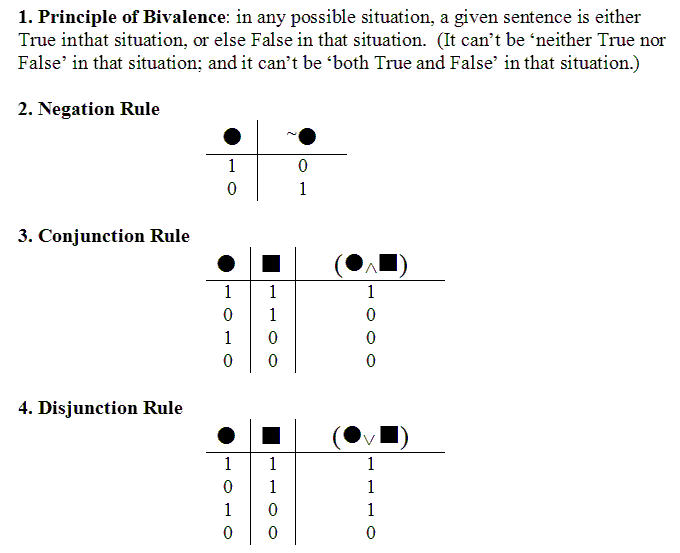
How, exactly, can our four semantic rules help us chase through the consequences of assuming a counterexample?
Well, notice first that in this situation we're already committed to the sentence letter "P" being False.
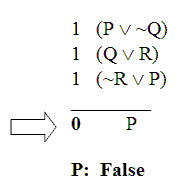
Now, if "P" is False in this situation, then Bivalence says: you can't turn around and tell us that "P" is also True in this situation. No, if "P" is False in this situation, then it's False all throughout this situation.
So, since "P" also shows up in the first and third premises, we've committed ourselves to "P" being False there as well.
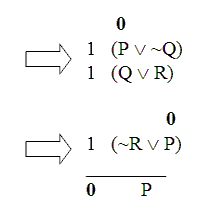
OK, now focus on that first premise. We know two things about that first premise:
(i) that its left half, "P", is False; and (ii) that the whole sentence is True.

But this premise is a disjunction, so it must follow the Disjunction Rule from our semantics.
Now, looking at the Disjunction Rule, we see that there's only one way that you can have the left half of the Disjunction False, but still have the whole disjunction True.
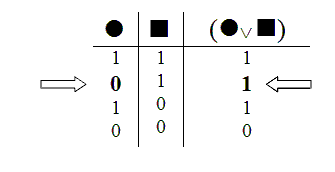
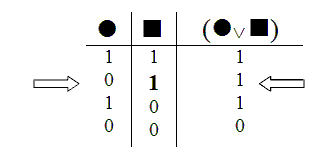
And we can apply this point to our first premise to get a new piece of information: since the left half of the disjunction is False, but the whole sentence is still True, we know that the right part must be True.

So we know that "~Q" must be True.
Now, if "~Q" is True, it's very simple to use the Negation Rule to figure out what "Q" is in this situation.
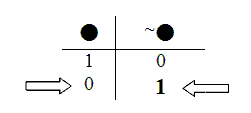
The Negation Rule says: if the whole negation is True, then the thing negated must be False:

So we have chased down one more consequence: we know that in this situation "Q" must be False.
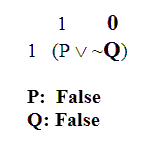
And once again, if we say that "Q" is False in this situation, we're committed to saying that "Q" is False all throughout this situation. So every time "Q" shows up in this situation -- like in the second premise -- it's False.

OK, let's look a little closer at that second premise.

We know two things about this second premise: we know (i) that the left part is False; and also (ii) that the whole disjunction is still True. Of course, this is the exact same situation that we had with the first premise. So we already know what the Disjunction Rule is going to tell us. It's going to say: if the left part is False, but the whole disjunction still manages to be True, it could only be because the right part is True.

So, here again in the second premise, we know that the right part must be True.

Now we've tracked down yet another consequence: "R" must be True in this situation.

Now, finally, we turn to the third premise. (This is where the action will really take place.)

Since "R" is True, the Negation Rule tells us that "~R" must be False.

So in this third premise, the left part ("~R") is False; and the right part ("P") is also False. But since this sentence is a disjunction, the Disjunction Rule tells us something new about this third premise: since both parts are False, the whole disjunction must be False.

So now we know something new: the third premise is False.

But wait: we said from the beginning that the third premise is True.

So now we've wound up with a very distressing result: in this situation, the third premise is both True and False at the same time.
But that's nuts: the Principle of Bivalence tells us that it's impossible for a sentence to be both True and False at the same time. Yet, that's what we wind up with, when we assume that the argument is invalid.
So let's review what happened:
(i) We assumed that the argument is invalid (by assuming that there is a counterexample -- a possible situation where the premises are all True, but the conclusion is False).
(ii) Then we used our good old semantic rules to chase through all the consequences of that assumption.
(iii) But the ultimate consequence of that assumption was that we would have a sentence (the third premise) which is True and False at the same time.
But we know from the Principle of Bivalence that that's impossible. So we know:
(iv) Our original assumption, that the argument is invalid, leads to a consequence that's impossible.So,
(v) Our original assumption, that the argument is invalid, must be false. The argument must have been valid all along.
There you have it: an indirect demonstration that the argument is valid.
Remember the basic steps to what we've just done:
(i) Assume that the argument is invalid (by assuming a possible situation where all the premises are True, but the conclusion is False).
(ii) Use the semantic rules to show that this assumption would lead to an impossible consequence (namely, a violation of Bivalence -- some sentence being True and False at the same time).
(iii) Since Bivalence says it's impossible for a sentence to be both True and False at the same time, we know this consequence must be False; and so the original assumption that leads to it must have been false as well. So our original assumption -- that the argument is invalid -- must have been false. So the argument must really be valid.
That's the basic technique for showing indirectly that an argument is valid. We'll streamline this technique a lot, with our improved bookkeeping techniques (which we'll introduce a little later). But already we can understand the basic indirect technique.
2. An Example of an Invalid Argument. Next, let's see what happens if we try this same indirect technique on an argument that really is invalid. What will the end result be then?
We don't have to search far for an invalid argument, because we already built a truth table earlier for a variation on our last argument. Back then, we asked what would happen if we changed the conclusion from "P" to "Q".
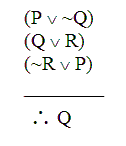
Is this new argument valid or invalid? Truth tables showed us that this argument is invalid.
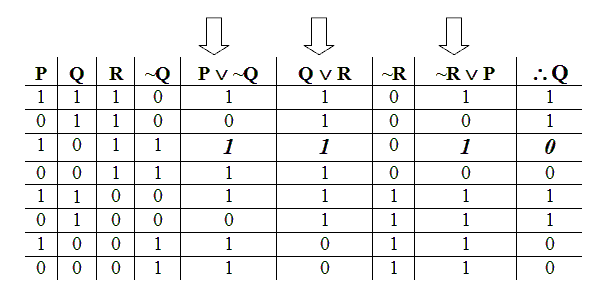
As we see from this truth table, the third valuation is a Counterexample -- a possible situation where all the premises are True, but the conclusion is False. So we know this argument is invalid.
Let's apply the same indirect strategy to this invalid argument, and see what happens.
We start the same way: assume that the argument is invalid, by assuming a possible situation where the premises are True, and the conclusion is False.
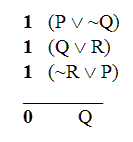
Now, just like before, we can start with the conclusion, "Q". We're assuming that "Q" is False; so "Q" must be False throughout this situation.
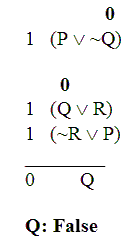
Now, focusing on the second premise, we see two things:(i) that the left part is False; and (ii) that the whole sentence is still True.

We're familiar with this situation by now: if the whole disjunction is True, even though the left part is False, then we know that the right part must have been True.

So we know that the right part of this sentence must be True.

So we know that "R" must be True in this situation.

So "R" must True throughout this situation.

Now look at the third premise.

Since "R" is True, the Negation Rule tells us that "~R" must be False.

And since "~R" is the left part of this disjunction, we find ourselves in the same familiar situation again: the whole disjunction is True, even though the left part is False. We know from the Disjunction Rule that the only way this could happen is if the right part is True.
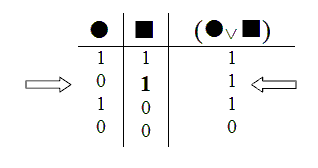
So we know that the right part of the disjunction, "P", must be True.

So "P" must be True throughout this situation.

And that leaves just the first premise unexamined.

Since “Q” is False, we know from the Negation Rule that “~Q” must be True.

In this first premise, we know that both parts of the disjunction are True; so the Disjunction Rule says that the whole disjunction must likewise be True. And that turns out to be -- exactly what we assumed about this first premise, from the outset!
Hmm -- we didn't get any nasty violation of Bivalence in this case, like we did with the last argument. Everything worked out consistently, and each sentence had only one truth value.
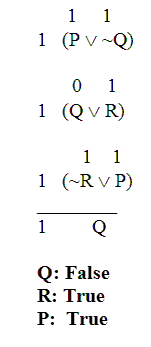
Here it turns out that it's not at all impossible to have all the premises True, but the conclusion False. Here it turns out that there really is a Validity Counterexample. So here it turns out that the argument really is invalid.
That's the other half of our indirect test of validity. We already saw the first half: if you assume that the argument is invalid, but that assumption blows up in your face (by violating Bivalence), then the argument was really valid all along. But now we add: if you assume that the argument is invalid, and that assumption doesn't blow up in your face, then the argument really is invalid.
OK, you say; that's pretty cool that the indirect strategy shows us that this last argument is invalid. But still, the truth tables told us more than that: the truth tables told us not only that the argument is invalid, but even exactly what the Counterexample is like.
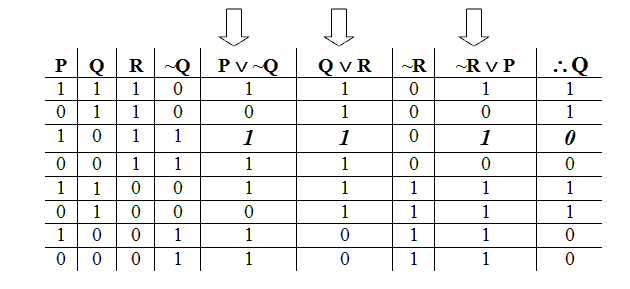
We see, from the truth tables, that the Counterexample is the third valuation -- the case where "P" is True, "Q" is False, and "R" is True.
But actually, our indirect test told us that information too:
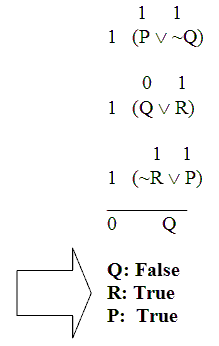
So the indirect test gives us all the information that the truth tables did.
But there is one big difference between the (direct) truth table method, and the indirect method: the number of steps involved. Let's count each sentence we write as one step; and likewise count each "1" or "0" we write as one step. OK, then the truth tables required 8 sentences written across the top, and 8 "1's" or "0's" below each of these sentences.
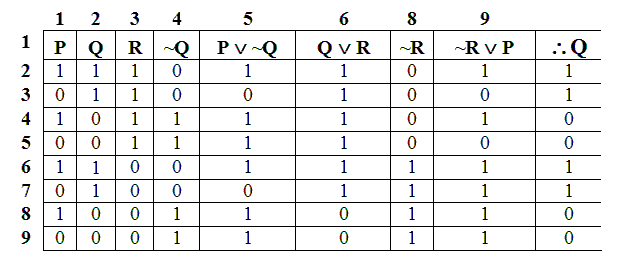
(I left off "Q" from the end, because we already have it listed on the left, between "P" and "R" -- I didn't want to count the same sentence twice.)
The truth table requires 8 x 9 steps -- that's 72 steps.
Now compare that with the indirect method.
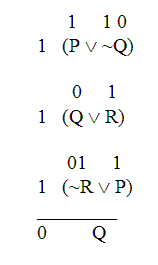
Here we write 4 sentences, along with 13 "1's" and "0's" -- 17 steps total. Compare those results:
Truth tables: 72 stepsThe indirect test gives us an enormous savings in labor. And that's the main reason we like the indirect test so much: because it lets us avoid work. If we weren't trying to get out of working, we could just stick with the truth table test of validity. But since we want to avoid work as much as possible, the indirect test is the right one for us.
Indirect test: 17 steps.
That's the first half of our improvements on the original test of validity: do it indirectly, rather than directly (with truth tables). Next, we streamline the indirect test even further -- and thereby cut down even further on the amount of work required. How? By getting rid of those annoying "1's" and "0's". And how do we get rid of those? Through improved bookkeeping -- the subject of the next lecture.
REVIEW OF INDIRECT TEST OF VALIDITY:
(i) Assume that the argument is invalid, by picturing a situation where all the premises are True, and the conclusion is False.
(ii) Use our semantic rules to follow through all the consequences of this original assumption.
(iii) If the original assumption of invalidity leads to a violation of Bivalence (some sentence being both True and False at the same time), then the argument is valid;
But if the original assumption of invalidity does not lead to any violation of Bivalence (if each sentence has only one truth value in that situation), then the argument really is invalid.